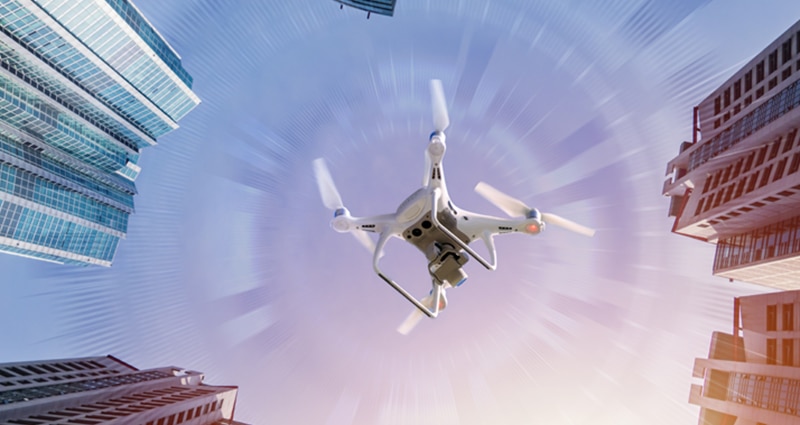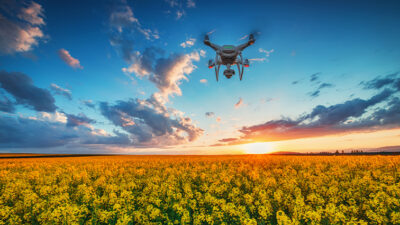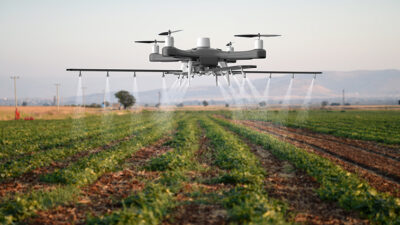Unmanned Aircraft Systems and Optimizing Operational Capabilities During the Pandemic

I think it’s safe to say that we are all waiting for the day when we can put COVID‐19 behind us and “get back to normal.” However, the reality is that this pandemic will continue to affect how we live our lives and conduct business for years to come. With numerous companies already making plans to continue work‐from‐home operations while investigating ways to integrate social distancing measures into routine tasks, drones have been called upon to assist with these efforts across multiple industries.
Drones in Public Safety, Law Enforcement and Beyond
During the early months of COVID‐19, the most public indication of increased drone use came from public safety and law enforcement agencies using drones to remotely monitor closed spaces and ensure that area residents were following social distancing guidelines. Some drone models were even equipped with speakers, allowing authorities to verbally communicate with members of the public to address improper actions.
Unmanned aircraft systems (UAS) provided local authorities with a tool to extend their reach, imperative when considering that local governments were being forced to reduce the number of employees in the field to best maintain safe social distancing practices.
Private sector staffing reductions also meant that critical operations had to be conducted with fewer individuals. For the last few years, many companies have gradually integrated drones into their operations on a limited scale to conduct proof of concept operations. And as drone use has been found to provide clear return on investment (ROI) in the form of cost savings, safety enhancements and/or process improvements, larger organizations have already begun to scale their UAS operations.
Faced with a need to reduce staffing and still maintain operational efficiency, drone use has quickly accelerated in multiple industries to better facilitate infrastructure inspections and facilities monitoring, and to serve as a “force multiplier” to increase individual employee effectiveness under relevant circumstances.
Increased Safety and Decreased Costs
It is no surprise that drone use is surging around the world when considering the benefits they provide. Drones accomplish two things in their most basic form: They enhance safety by removing humans from dangerous environments (climbing structures, entering contaminated areas, etc.), and they reduce costs by allowing imagery and data to be captured from an aerial perspective without the need for manned aircraft or the time required for a human being to move from one location to another.
Even simple safety inspections of equipment or infrastructures can involve a costly resource. For example, mandatory inspections of water storage tanks often require the use of expensive lifts or bucket trucks, multiple employees for safety purposes and hours or even days to gather the information necessary to complete the task. Drone use greatly minimizes costs as personnel requirements are reduced to single operators, and the time needed to gather necessary information is drastically reduced through automated flight capabilities.
Drone Use and Regulatory Limitations
One factor that has limited recent wide‐spread drone integration involves the regulatory limitations associated with their use. The Federal Aviation Administration (FAA) is responsible for the safe integration of UAS into the National Airspace System (NAS), a very complicated task involving an emerging technology. Above all else, the FAA must always ensure safety when considering the unforgiving nature of aviation mishaps.
Therefore, before any new technology can gain a firm foothold in our skies, it must be shown to be safe in the eyes of the FAA. This process takes time because the FAA needs to be educated on new technologies while fully understanding both their capabilities and weaknesses before enacting the necessary provisions to further a successful NAS rollout.
Unfortunately, the current hyper‐speed pace of business has no patience for the tortoise-like gait of regulatory development. As a result, many organizations have held off on scaling their UAS operations until either the FAA has removed some usage limitations or an unexpected and uncontrollable event has accelerated the process. Chances are that we will see both before the close of 2020.
In addition to the operational efficiency demands during a global pandemic, the FAA recently submitted budget proposals to the White House associated with the publishing of two new UAS regulations. The first, pertaining to the FAA’s Remote ID policy for small unmanned aircraft systems (sUAS), is a necessary hurdle that must be crossed in order to allow for more advanced commercial UAS operations, including routine Beyond Visual Line of Sight (BVLOS) operations. The second will define parameters for safe flight of UAS over “non‐participants,” or members of the general public; something that is essential for increased use of UAS in urban and even many suburban environments.
An Inflection Point in Drone Usage
Considering these combined factors, we are now seeing an inflection point with respect to drone usage across multiple industries, and signs indicate that there’s no turning back. While the first stages of the FAA’s UAS integration efforts have been slow to progress, officials have been diligent in educating themselves on the technology and are poised to make giant strides over the coming months and years.
Although the likelihood of “full‐integration” of sUAS by 2025—in accordance with the FAA’s original 2012 Roadmap—may still be low, I personally believe we’re going to be a lot closer than many industry professionals (myself included) expected to be less than two years ago, and that’s a very encouraging thought.
About the Author
Colin Romberger is the Chief Pilot at DARTdrones and graduated from Embry Riddle Aeronautical University as one of the first 5 students to earn a Master’s Degree in Unmanned Aircraft Systems, with a focus in Flight Operations and Systems Design. Colin also holds multiple FAA Airman Certificates for manned aircraft operations. At DARTdrones, Colin is responsible for ongoing instructor development initiatives, as well as the coordination of sUAS Operations Consultation Services tailored to the specific use cases and operating environments of our corporate clients in numerous sectors such as oil & gas, utilities, engineering and more. He has consulted with these companies and organizations on their use of sUAS for a cross section of purposes. Colin also runs his own drone services company specializing in mapping and inspections.

DARTdrones, the nation’s leading drone training company and Global Aerospace SM4 partner, offers courses in 40+ cities across the U.S. DARTdrones offers basic flight training classes, Part 107 Airman Knowledge test prep courses, advanced industry specific training, and UAS program implementation consulting services. DARTdrones has been helping individuals and organizations develop safe and efficient sUAS programs and continues to keep new and developing safety considerations at the forefront of their curriculum development. For more information, visit us or call the team at 800-264-3907. DARTdrones was featured on ABC’s Shark Tank in February 2017.
http://www.dartdrones.com
© 2025 DARTdrones. All Rights Reserved.
Next ArticleRelated Posts

Part 108: The Next Step in BVLOS Integration and Drone Innovation
As the drone industry awaits the Federal Aviation Administration’s (FAA) forthcoming Part 108 regulations, the landscape of Beyond Visual Line of Sight (BVLOS) operations stands on the brink of transformation. These anticipated rules aim to standardize BVLOS flights, enabling more complex and expansive drone missions across various sectors.

The Dawn of Drone Agriculture: Navigating the Skies of Modern Farming
In the past decade, the agricultural industry has seen a significant technological revolution, with the advent of drones, also known as Unmanned Aerial Vehicles (UAVs), being one of the most transformative. These high-flying tools have revolutionized the way farmers and agronomists approach crop management, pest control and land analysis.

